|
|
|
Sort Order |
|
|
|
Items / Page
|
|
|
|
|
|
|
| Srl | Item |
| 1 |
ID:
152885
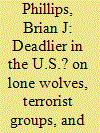

|
|
|
|
|
| Summary/Abstract |
Scholars, politicians, and pundits increasingly suggest lone wolf terrorists are substantial threats, but we know little about how dangerous these actors are—especially relative to other terrorist actors. How deadly are lone actor terrorists? A growing body of empirical research focuses on terrorist organizations, but similar work on lone actors is sparse. Furthermore, attempts to explicitly compare these or other types of terrorist actors are almost non-existent. This article considers theoretical arguments for why lone wolves ought to be especially lethal. However, it presents an argument for why terrorist groups should generally be more lethal. This argument is conditional upon the environment in which actors operate. Lone wolves should only be more deadly in states with especially strong counterterrorism capacity. The article uses data on terrorist attacks in fifteen developed countries, 1970–2010, to compare the lethality of terrorist acts. Around the world, attacks by organizations tend to be far more lethal than attacks by other actors. In the United States, however, lone wolves are generally the more lethal terrorist actors. This is argued to be because the robust counterterrorism capacity makes organized terrorism more difficult to accomplish.
|
|
|
|
|
|
|
|
|
|
|
|
|
|
|
|
| 2 |
ID:
092049


|
|
|
|
|
| Publication |
2009.
|
| Summary/Abstract |
This article takes a closer look at the relationship between democracy and transnational terrorism. It investigates what it is about democracies that make them particularly vulnerable to terrorism from abroad. The authors suggest that states that exhibit a certain type of foreign policy behavior, regardless of their regime type, are likely to attract transnational terrorism. States that are actively involved in international politics are likely to create resentment abroad and hence more likely to be the target of transnational terrorism than are states that pursue a more isolationist foreign policy. Democratic states are more likely to be targeted by transnational terrorist groups not because of their regime type per se but because of the type of foreign policy they tend to pursue. The empirical analysis provides support for the argument.
|
|
|
|
|
|
|
|
|
|
|
|
|
|
|
|
| 3 |
ID:
169932
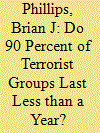

|
|
|
|
|
| Summary/Abstract |
Prominent scholars criticize terrorism research for lacking sufficient empirical testing of arguments. Interestingly, one of the most widely cited estimates in terrorism studies has not been evaluated using the many data sources now available. Rapoport’s 1992 claim, that perhaps 90 percent of terrorist groups last less than one year, has been described as part of the conventional wisdom. This estimate is frequently used to justify studies of terrorist group longevity, a substantial line of research in recent years. Is the estimate accurate? Scholars increasingly publish data sets of terrorist organizations, but no one has analyzed them collectively to see if the 90 percent claim holds up. This article examines the eight largest global data sets of terrorist group longevity, covering 1968–2013. The samples vary considerably, but the percentage of groups that do not survive beyond their first year in these relevant data sets is between 25–74 percent. Across all data sets, on average about 50 percent of terrorist organizations do not make it past their first year. There is some variation depending on group motivations, consistent with Rapoport’s “wave” theory. However, overall, terrorist organizations appear to be more durable than the conventional wisdom suggests.
|
|
|
|
|
|
|
|
|
|
|
|
|
|
|
|
| 4 |
ID:
137027


|
|
|
|
|
| Summary/Abstract |
Terrorist organizations often attack each other, but we know little about how this affects the involved groups. Some states encourage or turn a blind eye toward terrorist group interorganizational violence, hoping that it destroys at least one of the groups involved. This article argues that – contrary to the wishes of such governments – violent rivalries can contribute to the longevity of participating terrorist groups. Violent rivalries encourage civilians to take a side, inspire innovation, provide new incentives to group members, and spoil peace talks. Some of these mechanisms should be especially likely between rivals of different political goals (interfield rivalries), instead of between rivals seeking the same primary goal (intrafield rivalries). Illustrative cases in Colombia and Northern Ireland show that the theorized mechanisms occur in diverse environments. Quantitative global analysis of terrorist groups from 1987 to 2005, using original data on interorganizational violence, suggests that violent rivalries are generally associated with group longevity. Further analysis suggests that when rivalries are disaggregated by type, only interfield rivalries are positively associated with group longevity. Participation in violent rivalry is never found to increase a group’s chance of ending. The results suggest the importance of studying interorganizational dynamics, and raise questions about the notion of encouraging a violent rivalry as a way to hurt an involved terrorist group.
|
|
|
|
|
|
|
|
|
|
|
|
|
|
|
|
| 5 |
ID:
128982
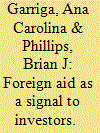

|
|
|
|
|
| Publication |
2014.
|
| Summary/Abstract |
Does development aid attract foreign direct investment (FDI) in post-conflict countries? This article contributes to the growing literature on effects of aid and on determinants of FDI by explaining how development aid in low-information environments is a signal that can attract investment. Before investing abroad, firms seek data on potential host countries. In post-conflict countries, reliable information is poor, in part because governments face unusual incentives to misrepresent information. In these conditions, firms look to signals. One is development aid, because donors tend to give more to countries they trust to properly handle the funds. Our results show that aid seems to draw FDI-however, this is conditional on whether the aid can be considered geostrategically motivated. We also show that this effect decreases as time elapses after the conflict. This suggests that aid's signaling effect is specific to low-information environments, and helps rule out alternative causal mechanisms linking aid and FDI.
aid
|
|
|
|
|
|
|
|
|
|
|
|
|
|
|
|
| 6 |
ID:
190972
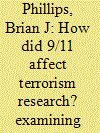

|
|
|
|
|
| Summary/Abstract |
Terrorism research increased markedly after the attacks of September 11, 2001 (9/11). How has research on this subject changed in the past twenty years? I examine data on more than 6,000 academic articles on terrorism between 1970 and 2019, and the more than 1,500 authors of multiple articles. This information comes from every article in the Web of Science database with “terrorism” or “terrorist” in the title. Several primary findings emerge. (1) The volume of terrorism research surged to record highs after 9/11, and has not decreased since. (2) Psychologists became the most numerous terrorism researchers after 9/11, displacing political scientists for about ten years. Research on health or medical aspects of terrorism jumped after 9/11. (3) The proportion of female scholars increased substantially after 9/11, outpacing the rise in academia generally. This is in part because scholars new to the field were often from disciplines with relatively high percentages of women, such as psychology. (4) Terrorism scholars were mostly based in North America or Western Europe before 9/11, but the number of countries with scholars publishing terrorism research expanded considerably after 2001. Overall, terrorism research has developed in many ways over the decades, but 9/11 led to fundamental changes.
|
|
|
|
|
|
|
|
|
|
|
|
|
|
|
|
| 7 |
ID:
133650
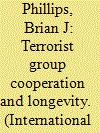

|
|
|
|
|
| Publication |
2014.
|
| Summary/Abstract |
Why do some terrorist groups survive considerably longer than others? The literature is just beginning to address this important question in a systematic manner. Additionally, and as with most studies of terrorism, longevity studies have ignored the possibility of interactions between terrorist groups. This article attempts to address these two gaps in the literature: the incomplete understanding of terrorist group survival and the tendency to assume that terrorist groups act independently. In spite of risks associated with cooperation, I argue that it should help involved terrorist groups mitigate mobilization concerns. More importantly, the impact of cooperation is conditioned by attributes of the country in which a terrorist group operates. Using new global data on terrorist groups between 1987 and 2005, I show that cooperation has the strongest effect on longevity in states where groups should have a harder time operating-more capable states and less democratic states. Interestingly, a group's number of relationships is more important than to whom the group is connected.
|
|
|
|
|
|
|
|
|
|
|
|
|
|
|
|
| 8 |
ID:
168388


|
|
|
|
|
| Summary/Abstract |
Terrorist group rivalries and alliances have important consequences, but the sources of these relationships are debated. This article offers a side-by-side examination of correlates of terrorist rivalries and alliances. Global analyses of hundreds of terrorist groups find violent rivalry is associated with drug trafficking, state sponsorship, ethnic motivation, and operating in a civil conflict country. Alliances are associated with territorial control, intermediate membership size, and religious motivation. The idea that alliances are an indicator of weakness does not find much support. When relationships are disaggregated into theoretically relevant categories (inter-field and intra-field rivalries, and domestic and international alliances), further distinctions appear.
|
|
|
|
|
|
|
|
|
|
|
|
|
|
|
|
| 9 |
ID:
138782


|
|
|
|
|
| Summary/Abstract |
Researchers increasingly conduct quantitative studies of terrorist groups, which is an important advance in the literature. However, there has been little discussion of what constitutes a “terrorist group,” regarding conceptualization or measurement. Many studies of terrorist groups do not define the term, and among those that do, definitions vary considerably. The lack of clarity leads to conceptual confusion as well as sample selection issues, which can affect inferences. To address these issues, this article offers an in-depth analysis of the term and its use. It explores definitions in the literature, and then discusses different samples used. Empirically, the article demonstrates how sample selection can affect variable values. It also shows that a non-representative sample, such as the U.S. Foreign Terrorist Organization list, can lead to inaccurate generalizations. Ultimately, I present a straightforward “inclusive” definition, and argue for its practicality. Other suggestions are made for a more effective and cohesive research program.
|
|
|
|
|
|
|
|
|
|
|
|
|
|
|
|
| 10 |
ID:
112613


|
|
|
|
|
| Publication |
2012.
|
| Summary/Abstract |
Political organizations claim they are serving the interests of their constituents-but being involved in the drug trade does not seem to support those claims. Why would political organizations sell drugs then? Most often the question of why organizations engage in the drug trade has been explored in the context of organizations that are either criminal or violent, thus leaving a large hole in the literature about how violence and legality intersect with other exploratory factors. We explore this issue more fully by looking at both violent and nonviolent organizations using the Middle East Minorities at Risk Organizational Behavior dataset, which has data on over 100 ethnopolitical organizations in the Middle East. Very few of these organizations are involved in the drug trade and yet all of those are engaged in violence at the same time. We explore what factors, other than violence, make this rare behavior for political organizations more likely.
|
|
|
|
|
|
|
|
|
|
|
|
|
|
|
|
|
|
|
|
|